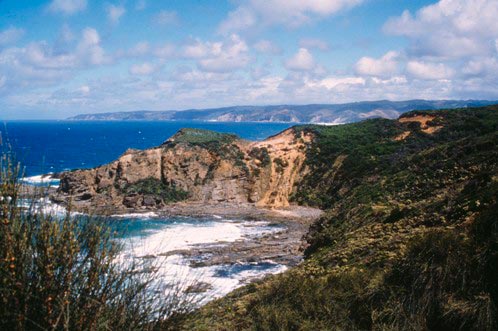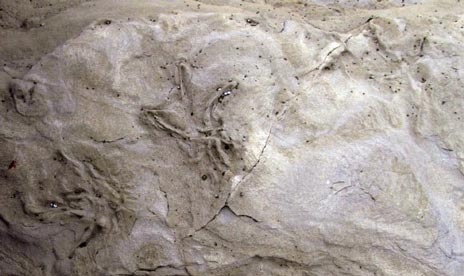Evidence of Australia’s Oldest Feathered Friend
A team of scientists has identified a pair of 100-million-year-old fossilised bird tracks – the oldest ever discovered in Australia. The fossilised tracks, likely made by two individual birds, each the size of a heron, were found at the famous Dinosaur Cove site, approximately 125 miles south-west of Melbourne (Victoria). The tracks were discovered as part of a long term project being conducted by a team of scientists including Museum Victoria’s Dr Tom Rich, Dr Patricia Vickers-Rich and Michael Hall from Monash University and Dr Anthony Martin from Emory University in the United States.
Dinosaur Cove
Dr Martin stated:
“We know the tracks were made by birds because of the rear-pointing toes. The tracks show a beautiful mark caused by the back toe dragging in the sand, which indicates the bird was flapping its wing and coming in for a soft landing. Discoveries like these help us better understand avian evolution.”
One of the problems ichnologists have (ichnology is the study of trace fossils, specifically foot prints and tracks), is distinguishing between tri-dactyl dinosaur footprints typically made by members of the Theropoda and those made by birds that lived alongside the Dinosauria. The back toe (hallux) may not leave an impression so it is very difficult to tell the difference between the two.
The Fossil Dinosaur Cove Site (Victoria, Australia)
Picture Credit: Dr Tom Rich/Museum Victoria
Early Cretaceous Tracks
Dr Rich explained:
“The tracks date back to the Early Cretaceous, a time that spans from 100-million years ago to 140-million years ago when Victoria was still connected to Antarctica. The tracks were made in what was once the moist sand of a riverbank during a polar spring or summer most likely.”
Dinosaur Cove has produced a remarkable number of fossil finds over the last forty years or so. This location, in combination with the East Gippsland locations has revealed a diverse assemblage of vertebrate fossils including the dinosaurs Leaellynasaura, Qantassaurus, as well as numerous theropods, pterosaurs, fish, giant labyrinthodont amphibians, turtles and potentially evidence of ornithomimid dinosaurs – a first for Australia. What is remarkable is that, this part of Australia was at approximately 75 degrees south for much of the Early Cretaceous.
Oldest Bird Tracks
The area was covered by extensive polar forests and for nearly two months of the year, the high southerly latitude meant that there was total darkness, with the sun not appearing above the horizon during the winter. In the summer, there were periods of 24-hour daylight. The research team are unsure as to whether these bird tracks were made by residents or migrants that came to the area to exploit the 24-hour feeding opportunity during the summer months.
The bird tracks are estimated to be around 105 million years old, making them the oldest evidence uncovered to date of Aves in Australia.
Ancient Birds Walked this Way
Picture credit: Alan Tait
A spokes person from Everything Dinosaur stated:
“Back in 1999 when the ground breaking BBC television series “Walking with Dinosaurs” was being made, an episode was dedicated to the amazing fossil discoveries from Dinosaur Cove and East Gippsland. The programme was entitled “Spirits of the Silent Forest”, but as no evidence for an Avian presence had been found, no birds were featured. We suggested at the time that birds were most likely present, perhaps migrating to this area to breed and we imagined vast breeding colonies, it now seems that there is fossil evidence to support the theory that birds inhabited or at least were present in this habitat for some part of each year.”
Everything Dinosaur would like to thank Museum Victoria for their help in putting together this article.







Leave A Comment